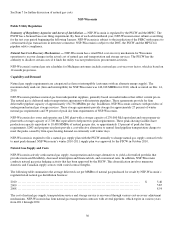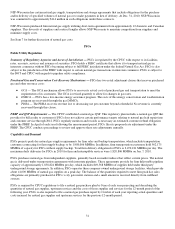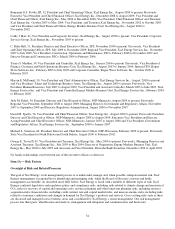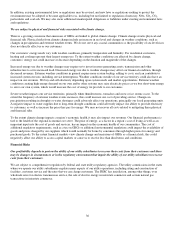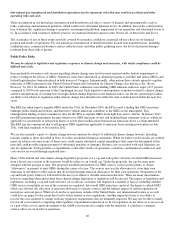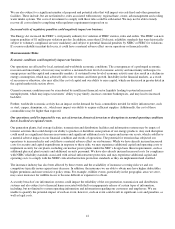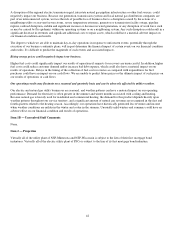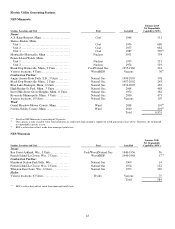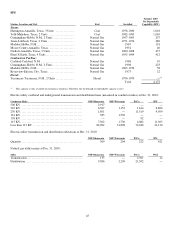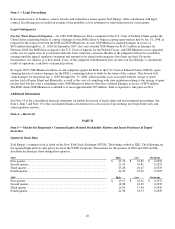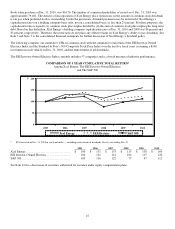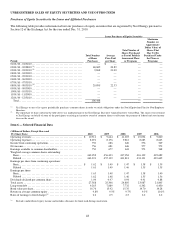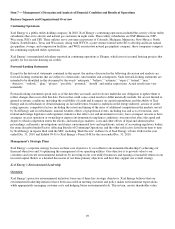Xcel Energy 2010 Annual Report Download - page 50
Download and view the complete annual report
Please find page 50 of the 2010 Xcel Energy annual report below. You can navigate through the pages in the report by either clicking on the pages listed below, or by using the keyword search tool below to find specific information within the annual report.40
Our natural gas transmission and distribution operations involve numerous risks that may result in accidents and other
operating risks and costs.
There are inherent in our natural gas transmission and distribution activities a variety of hazards and operating risks, such as
leaks, explosions and mechanical problems, which could cause substantial financial losses. In addition, these risks could result in
loss of human life, significant damage to property, environmental pollution, impairment of our operations and substantial losses to
us. In accordance with customary industry practice, we maintain insurance against some, but not all, of these risks and losses.
The occurrence of any of these events not fully covered by insurance could have a material adverse effect on our financial
position and results of operations. For our natural gas transmission or distribution lines located near populated areas, including
residential areas, commercial business centers, industrial sites and other public gathering areas, the level of potential damages
resulting from these risks is greater.
Public Policy Risks
We may be subject to legislative and regulatory responses to climate change and emissions, with which compliance could be
difficult and costly.
Increased public awareness and concern regarding climate change may result in more regional and/or federal requirements to
reduce or mitigate the effects of GHGs. Numerous states have announced or adopted programs to stabilize and reduce GHGs, and
federal legislation has been introduced in both houses of Congress. Internationally, other nations have already agreed to regulate
emissions of GHGs pursuant to the United Nations Framework Convention on Climate Change, also known as the “Kyoto
Protocol,” by 2012. In addition, in 2009, the United States submitted a non-binding GHG emission reduction target of 17 percent
compared to 2005 levels pursuant to the Copenhagen Accord. Such legislative and regulatory responses related to climate change
and new interpretations of existing laws through climate change litigation create financial risk as our electric generating facilities
are likely to be subject to regulation under climate change laws introduced at either the state or federal level within the next few
years.
The EPA has taken steps to regulate GHGs under the CAA. In December 2009, the EPA issued a finding that GHG emissions
endanger public health and welfare, and that motor vehicle emissions contribute to the GHGs in the atmosphere. This
endangerment finding created a mandatory duty for the EPA to regulate GHGs from light duty motor vehicles. In January 2011,
new EPA permitting requirements became effective for GHG emissions of new and modified large stationary sources, which are
applicable to construction of new power plants or power plant modifications that increase emissions above a certain threshold.
The EPA has also announced that it will propose GHG regulations applicable to emissions from existing power plants in July
2011, with final standards to be issued in 2012.
We are also currently a party to climate change lawsuits and may be subject to additional climate change lawsuits, including
lawsuits similar to those described in Note 14 to the consolidated financial statements. While we believe such lawsuits are without
merit, an adverse outcome in any of these cases could require substantial capital expenditures that cannot be determined at this
time and could possibly require payment of substantial penalties or damages. Defense costs associated with such litigation can
also be significant. Such payments or expenditures could affect results of operations, cash flows, and financial condition if such
costs are not recovered through regulated rates.
Many of the federal and state climate change legislative proposals use a cap and trade policy structure, in which GHG emissions
from a broad cross-section of the economy would be subject to an overall cap. Under the proposals, the cap becomes more
stringent with the passage of time. The proposals establish mechanisms for GHG sources, such as power plants, to obtain
“allowances” or permits to emit GHGs during the course of a year. The sources may use the allowances to cover their own
emissions or sell them to other sources that do not hold enough emission allowances for their own operations. Proponents of the
cap and trade policy believe it will result in the most cost effective, flexible emission reductions. There are many uncertainties,
however, regarding when and in what form climate change legislation or regulation will be enacted. The impact of legislation and
regulations, including a cap and trade structure, on us and our customers will depend on a number of factors, including whether
GHG sources in multiple sectors of the economy are regulated, the overall GHG emissions cap level, the degree to which GHG
offsets are allowed, the allocation of emission allowances to specific sources and the indirect impact of carbon regulation on
natural gas and coal prices. While we do not have operations outside of the United States, any international treaties or accords
could have an impact to the extent they lead to future federal or state regulations. Another important factor is our ability to
recover the costs incurred to comply with any regulatory requirements that are ultimately imposed. We may not be able to timely
recover all costs related to complying with regulatory requirements imposed on us. If our regulators do not allow us to recover all
or a part of the cost of capital investment or the O&M costs incurred to comply with the mandates, it could have a material
adverse effect on our results of operations.


